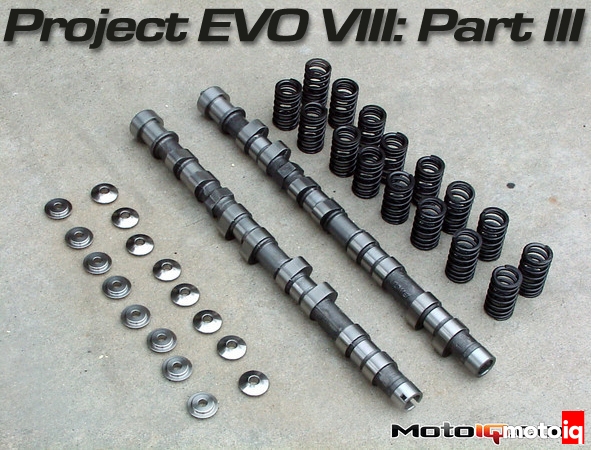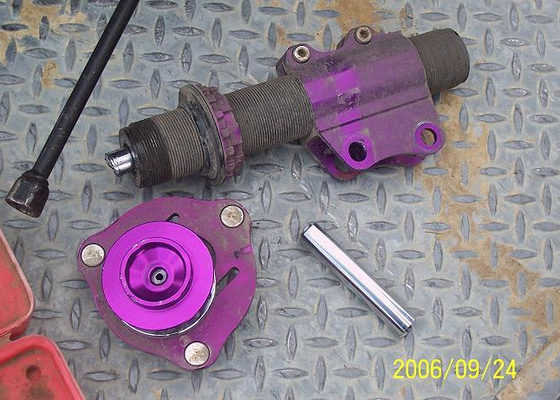,
 |
| We chose Unorthodoxes’ adjustable timing gears because they are the lightest 4G63 gears on the market and they have five instead of four bolts to reduce the chance of slippage. The gears proved to be a good bang for the buck. |
We next installed a pair of Unorthodoxes’ Ultra Series adjustable timing sprockets, which we found to be the lightest on the market by a few ounces. After a round of dyno tuning we gained one peak hp up to 245.7 hp but as much as 11 more hp after the peak, effectively flattening out the powerband and giving excellent top end pull by retarding both the intake and exhaust cams by 4 degrees. Of course we were still plagued by considerable run to run power variation and this was a conservative run.
 |
| The Tomei Procam with valve springs and titanium retainers gave the biggest gains of any one set of parts so far once the cam timing was adjusted. |
Next we installed a set of Tomei Pro series cams with valve springs and a set of their lightweight titanium retainers. The Tomei cams are a short duration high lift design featuring a lift of 11.5mm and a duration of 260 degrees with recommended lobe centers of 110 degrees on the intake and 115 degrees on the exhaust. After the cams were installed and broken in we changed our oil to Motul 300V synthetic in 15w50 for protection even under severe track use. We also used a genuine Mitsubishi oil filter. With fast valve action caused by the lift with this short duration, Tomei springs are mandatory with these cams. The cams short duration makes for a nearly stock idle, no loss of bottom end power at all and good driveablity. We feel that the cams and the exhaust tie for the honor of best bolt on mod dramatically increasing power above 4500 rpm with no loss in power on the bottom end. We experienced a peak gain of 8 hp, now up to 253.7 hp with a gain of 14 hp after the power peak. Unfortunately the dyno operator only took data to 7000 rpm on this and subsequent runs when our prior data went to 7500 rpm. If we extrapolate our power curves to 7500 rpm I estimate our peak gains would be in the 25 hp range. Of course we selected a conservative run to report these gains and we still suffered from much run to run variability although the cams reduces this variability somewhat.
 |
| An Aquamist water injection system helps suppress knock and reduce power variation from run to run. |
In an effort to suppress the detonation and changes in boost pressure and spark advance we were experiencing. We installed an Aquamist water injection system. Now usually water injection does not experience gains unless the engine is tuned around the water, and/or the boost pressure is increased but we just wanted to see what the water’s affects would be. The Aquamist system is unique in that it uses a high-pressure 130 psi pump and atomizing nozzles that provide a fine spray of mist vs a stream of water. The pulsating effect of the pump produces a variety of sizes of water droplets. Fine drops vaporize right away and provide charge cooling. Bigger drops reach the cylinders and suppress combustion and detonation. Water injection is very useful in road racing and does a great deal to keep the engines temperature down and insure reliability. We used a hobbs pressure switch to trigger out water injection at about 10 psi of boost. The Aquamist system can be tuned by changing nozzle size and nozzles from .5mm to 1.0 mm in .1 mm increments are available. We used a .7mm nozzle to start with. Normally if water is injected into an efficient turbo motor without any tuning changes, a power loss results this is usually around 10-15 hp. We were expecting this and that’s what we got. We lost nearly 11 hp to the water but the interesting thing is that with the elimination of detonation all of our power runs were now very consistent. Since we know that the water is working to stop detonation, in our next edition of our series we will tune the motor and water injection system to exploit what can be done with very poor quality gas.
 |
| The Aquamist water injection system made a pretty big difference with no other tuning changes. |
Finally we readjusted our cam timing running the exhaust cam straight up and the intake cam 2 degrees retarded. We were rewarded with an 8 hp gain to 262 hp with no loss of power anywhere else in the powerband. The combination of cams and timing gears is awesome, 16 more peak hp and if our dyno operator had revved it to 7500 rpm, we suspect a peak gain of 50 hp could have been had at high rpm. When the cam timing is optimized, the Tomei cams are the best single mod we have applied to Project EVO.
 |
| Our before and after results are pretty impressive just for bolt ons! |
All in all we have gained 30 more peak hp and a minimum of 3 hp right off of idle all the way to an estimated 50 more hp at 7500 rpm. Our maximum verified gain is nearly 40 wheel hp. Although this is seemingly impressive we are disappointed. Other EVO tuners have gotten 300 whp with similar mods but with higher than stock boost levels and 93 or 94 octane fuel, we cannot turn up our boost without detonation so if you consider this, we are not doing as bad as it might seem. Our bad gas is hampering things beyond belief and we are pulling our hair out in dealing with it. In our next edition of Project EVO we will do a bunch of ECU tweeking and tune around our water injection in an attempt to reliably get over 300 whp on 91 octane gas. We will do our best to deliver, don’t laugh at us too much, we’ll be back, crappy gas or not.
To see the other segments of Project EVO, Click Here!
Sources



